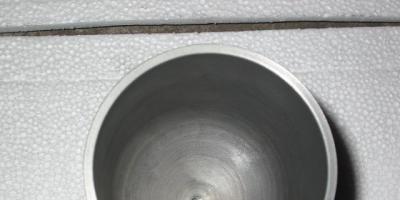visibility 64 views

A durable hammer that can withstand high impact force and at the same time a rubberized outside hammer is easy to make with your own hands. The mold for casting it is done simply, and the materials you will need are quite affordable. Step by step process How to make a concrete hammer with your own hands is outlined and clearly demonstrated below.
Materials
Before you make a hammer with your own hands, make sure you have:
- Lego constructor;
- concrete mixing solution;
- solution epoxy resin;
- wooden handle;
- sharp knife or screwdriver;
- wax for polishing wood;
- chisels;
- sandpaper;
- gloves;
- corner.
Step 1. Using Lego, assemble a mold for casting the striking part of the hammer. The good thing about the constructor is that its parts fit as closely as possible to each other, preventing the solution from leaking out through the cracks. The product can be made to any size. In this case, a small hammer was needed. You can change it at your own discretion.

Step 2. Place a wooden handle in the center of the assembled mold for casting the hammer. Be sure to make sure that the part of the future tool is durable and not rotten. For the handle, choose strong types of wood; in this master class it was walnut.

Step 3. Dilute the concrete solution in accordance with the manufacturer's instructions and pour it into the mold. Make sure that the handle continues to stand strictly vertical during the process. Adjust it if necessary. Compact the solution with your hands, after wearing gloves. Be sure to ensure that no air pockets form. The solution must be compacted tightly.



Step 4. After a few hours, disassemble the constructor. Due to smooth surface plastic, the process will go without much effort, but if you doubt that it can be separated from the concrete, lubricate the mold before casting vegetable oil. Give the material a little more time to dry.

Step 5. Dilute the epoxy resin solution. It should be viscous. Using a pencil, carefully apply it to the concrete part of the hammer. Leave the product until the materials are completely dry. This process will take about a day.


The resin will hold the concrete together from the outside and due to this layer, the hammer will be not only durable, but also similar in properties to its rubber counterpart.
Step 6. To ensure that the hammer handle fits comfortably in your hand and does not rub calluses, cut off its edges and sand everything thoroughly. Rub the surface of the wooden part of the instrument with wax and polish.

Think you know everything about hammers? What could be simpler - handle, striking part, hammer, and rejoice! There really is nothing complicated in their design, but you can get confused in the varieties. Locksmith's hammer, nail puller, with or without a striker, pickaxes - it's time to learn the whole truth about hammers!
Types of hammers - functional differences
Hammer - ancient instrument, and we can only guess for what purposes the ancient people used it. But today it is a construction tool, without which not a single repair or construction project can be completed. It’s still possible without a nail, but without a hammer it won’t work! Its design is designed to increase the force of a person’s blow by several times and concentrate this force into one point - a person faces this need in almost every area where it is necessary to use force.
By functional purpose These tools are divided into claw hammers, picks and hammers with strikers. Nail pullers are especially useful in household- this way you can not only hammer a nail, but also, if necessary, pull it out. The peculiarity of the design is that on the reverse side there are two arches bent inwards, which are convenient for hooking the nail head. These hammers are especially popular among carpenters and builders. Hammers with strikers are mainly used for carpentry work, but sometimes tilers also need them. The shape of the strikers can be very different: square, round, narrow and wide, and so on.
The mason's and tiler's hammer is a hammer with a flattened reverse side, which is easy to deliver cutting blows. With their help, you can split stones, remove excess brick or hardened concrete from the surface. Hatchet hammers are similar in design, the reverse side of the strikers is flattened and sharpened so that, if necessary, they can split or chop a thin object.
Much less common are types of hammers that do not bounce off the surface. These are used to work with sheet metal and products requiring high precision. The ability to prevent backward movement is provided by a cavity in the metal part of the hammer, which is filled half or three-quarters with metal shot. When the movement of the tool is directed towards the impact, the balls collect in the rear part of the cavity, while during the impact itself they move forward by inertia, almost completely outweighing the inertia of the rebound.
What kind of hammer can there be - a metalworker's hammer, a soft one, a mallet?
There are hundreds of hammers available in different shapes and sizes. If you highlight the main forms, you get this picture:
- Thanks to their tapered back, locksmith's hammers can hammer even the smallest nails. The material from which the working part is made is chrome vanadium steel. There are two types of machinist's hammer - one has the shape of a rectangle with a square head, the second is slightly convex, round in shape. By weight they are divided into 5 standard numbers. The first number weighs 200 grams, while the fifth weighs all 800. There are also specialized products weighing from 0.05 kg to 1 kg.
- “Soft” hammers are tools for hammering fragile materials. Typically, the strikers of such tools are made of aluminum, copper, rubber, polyurethane, nylon and wood. The most practical purchase will be a hammer with interchangeable heads, thanks to which you can perform a huge range of work.
- A hammer with a notch on the striker prevents the striker from sliding off the nail head when struck. Most often used in carpentry.
- The roofer's hammer is characterized by a special recess on the top of the striker in which nails can be secured different sizes. This simplifies the work when it is not possible to hold a nail with one hand and strike with a hammer with the other. The recess contains a small magnet that holds the nail when struck.
- A hammer with an addition on the back of the striking part in the form of a claw is the so-called claw hammer.
- A mallet hammer is most often used to hammer in chisels, so the material for its manufacture is the same type of wood from which the chisel handle is made. Essentially, a mallet is wooden hammer, often made from one piece of wood.
- Balda is a hammer for strong men! The history of the funny name has been lost for centuries, but the instrument itself does not face such a fate - it is necessary in almost every construction or serious repair. It looks like a huge hammer with a long thick handle and a large, heavy hammer, which is also called a sledgehammer. Usually such big guys are needed to break something, but it’s very difficult to hammer like that without damaging the material itself.
Let's buy the right hammer!
When going to purchase this tool, the most important thing is to decide on the size and weight of its working part. A striker that is too light will not provide the required impact force, and on the contrary, a striker that is too heavy will quickly wear you out during work. In addition, a heavy hammer can cause deep injury or accidentally damage the material itself.
When purchasing, also pay attention to the material from which the working part is made. The head should preferably be forged, hardened and tempered. Hardening is carried out by an increased cooling rate of the material, but such a material has high internal stress. To remove it, tempering is carried out - heating the product in an oven to a temperature of 150-250 ° C, followed by gradual cooling.
Although tempering somewhat reduces the hardening strength, in general, a product that has gone through these stages is much stronger than ordinary metal parts.
Handles in Lately are made from the most different materials: plastic, polyurethane, fiberglass. But a wooden handle, based on the centuries-old experience of craftsmen, remains the most popular material. Firstly, you can drive a peg into the wooden handle, which significantly strengthens its grip on the striker. Secondly, you can make such a handle yourself if the old one breaks or becomes unusable for some other reason.
How to store and carry a hammer?
The hammer should always be at hand while working, but do not hold it constantly! For these purposes, there is a special belt with a convenient holder, which, however, can be made independently, from wire or a piece of leather. The point of the holder is that it allows the handle to pass through the hole, but the firing pin cannot. Thus, the instrument is placed on the belt with the handle down.
For easy storage of hammers and mallets, it is best to drill holes at the end of the handle(if it was not provided by the manufacturer) and make a stand with stuffed carnations convenient sizes. If you do not provide this instrument with a permanent “place of residence,” you can be sure that you will spend more than one minute looking for it at the most necessary moment.
Electric version – jackhammer
Although a jackhammer is strikingly different from its older “brother,” the principle of operation is the same - striking at one point. It’s just that it’s unlikely that you’ll be able to hammer a nail with the hammer option, at least no one has tried it yet. Its main function is dismantling various surfaces, structures, punching openings and niches in walls, changing road surfaces and much more.
The tool is to some extent similar to an electric one, but a jackhammer has a more reliable and simplified design with increased impact force. The higher the force of the blows and their number, the better tool. The principle of operation of the bump stop is completely simple - inside the striker strikes the working part, which, after being thrown from the blow, returns to its original position. In addition to its destructive function, a jackhammer, with the help of various platform-type attachments, is capable of compacting the surface.
In this article we will show you how to create a creative hand-shaped hammer handle.
Hello!
This time I came across an old Soviet hammer without a handle, which had been lying around idle in my workshop for a long time.


The Internet is full of pictures with the anatomical structure of bones. We choose a more informative and simple drawing, estimate the dimensions of the hammer and approximate size bones and cut the reinforcement.
In my work I took 12 mm as a basis. round fittings for the handle and 10 mm. for fingers.
The only tools I needed were:
- welding machine.
I used a semi-automatic device, but an inverter for the RDS, which may well be in yours, will also work well here!
The workflow is quite simple, so instead of tons of text, I'll just go through the chapters and mark the process in the photo.
I did all the sampling of the excess on the bones using a grinder's grinding wheel. 

For the hammer I made it from 2 pieces of reinforcement. The photo shows that I marked the length of the handle + the segment on which I will subsequently weld the bones + seat under the hammer itself.

I also betrayed the relief of the handle welding machine and tapping a little, it turned out to be a kind of handle for a hammer in garage conditions.

And now when all the individual parts are ready: hammer, fingers, handle; We start assembling and welding. 


After the hammer was ready, I decided to oxidize it a little and rust it - so to speak, to give it some atmosphere to the work.
I doused the hammer with water from a sprayer, which made the hammer darken and give it a more interesting look.
Well, you can see the result and the complete process in the video!
A hammer is the most important tool in the house. And he will hammer a nail, and split a nut, and straighten the wire. This is the father of all equipment and all tools. The development of hammer production is characterized by high level progress, so you can easily find the most effective tool for each activity. If you do metalwork, then you will need a plumber's hammer. Without this percussion instrument no master can do without.
The purpose of a plumber's hammer
Humanity has known and used a hammer for a very long time - even at the dawn of existence. This is the very first tool, as well as a part-time weapon of primitive man. People, as they developed, improved and changed the hammer. The materials of hammers of ancient times corresponded to the development of people and changed in the following sequence: bone - wood - bronze.
The design of the hammer has not changed these days: the butt plate, the striking part with the striker and the handle. The firing pin and the handle are connected to each other through a hole in the body and a wedge driven into the handle. The tail may be various shapes. The body is usually made of steel, but can be made of copper, wood, lead and rubber. The handle is most often made of wood, metal or plastic.
There are many types of hammers. Doctors and architects, cooks and musicians, not to mention carpenters, metalworkers, mechanics and builders, use hammers in their work. The most famous hammers are copper hammers, sledgehammers, straightening hammers, carpenter's hammers, mason's hammers and metalworker's hammers.

It is the last of these, the plumber’s hammer with a round striker, that is the most common and versatile. Its purpose is to prolong, direct and increase the effort of the human hand, delivering an energetic blow to the desired point, assisting another tool - a chisel, chisel, punch.
It is convenient for them to make blows for a variety of work: bending, chopping, riveting, straightening, punching holes, hammering and flattening. A plumber's hammer is used to hammer nails, break concrete or ceramic tiles, give metal tubes their shape.
Construction of a plumber's hammer
A locksmith's hammer differs from a regular hammer in that it has 2 different strikers in its design - a straight one, which is intended for driving nails, and a tapered end, which is convenient for breaking different objects and surfaces. The tool has a slightly convex, not knocked down or oblique surface of the striker, without hardening, bevels, burrs, potholes and cracks.
The price of locksmith hammers with a square striker is cheaper, so this variety is widely used in locksmith practice for light work. And hammers with a round striker have one advantage, which is that the striking part significantly outweighs the rear, which ensures greater accuracy and impact force.

The force of impact with a plumber's hammer depends on the level of gravity of the working part and the movement of the tool. This speed is regulated by a person, and the severity of the working element is regulated by the manufacturer. The impact part of the tool is made of heat-treated steel to ensure high strength and hardness. Therefore, the material used to create hammers is varied.
The striking part of the hammer is usually mounted on an ergonomic handle made of fiberglass or wood. Wood is predominantly used for the handle hard rocks(hornbeam, beech, dogwood or birch) and have a length of at least 250 millimeters for hammers. Bench hammers weigh 0.4 - 0.8 kilograms.
Making a plumber's hammer
A plumber's hammer has one weak spot - the section of the hammer handle, which is located under the striker. When driving pins, nails, wedges, problems arise, especially on initial stage fastening them, craftsmen often miss the target and usually hit the nail not with the striker, but with this section of the handle.
As a result, chips and gouges appear on the handle. Hammers very often become loose, fly off the handle, or break. And buying a plumber's hammer does not guarantee the opposite, since plumber's hammers do not have a special tongue for protection, as, for example, in axes.

Of course, in retail outlets and construction stores hammers with plastic or metal handles are presented, which are completely devoid of the problem of fitting the head, however, locksmith's hammers with wooden handles are traditional. In addition, they fit more securely in the hand and are warmer to the touch.
Therefore, today we will make a DIY hammer with a wooden handle. Remember that it is enough to firmly and securely fasten the handle on it once, and it will work without question.
Handle of a plumber's hammer
So, let's start by making a handle for a plumber's hammer. First, let's talk about the dimensions: the handle should have an oval cross-section, approximately 250 - 350 millimeters long, tapering smoothly towards the end on which the tool head will be mounted. The best wood for making a handle is beech, oak, birch, maple, hornbeam, ash or rowan. It is considered absolutely unacceptable to make handles from easily scratchy wood: spruce, pine, alder or aspen.
Most often, handles for plumbing hammers are made from birch. To do this, you will need a small board, from which you need to carve the shape of a handle according to technological map making a plumber's hammer, then sand it well using construction sandpaper.

If you plan a handle from a thick birch branch, it must be dried in a warm, well-ventilated and shady place. Do not try to dry wood using artificial heat sources: air heaters, electric fireplaces and radiators, because with such drying the wood will inevitably crack and lose its strength.
If the wooden handle for a plumber's hammer is not sufficiently dried, it will dry out over time and decrease in volume. And therefore the head will dangle on it, constantly trying to fly off the hammer handle. To make the handle even smoother, it is recommended to coat it with a special furniture varnish. That's it, the handle for the plumber's hammer is ready, you can move on to the next stage.
Connection of head and handle
After making the handle, you need to insert its thin end into the hole in the tool head. It is considered ideal to fit the head of a metalworker's hammer on the handle with a certain force or “with interference,” as the craftsmen used to say.
If the handle turns out to be thick, you should first process its thin end with a rasp, and then - sandpaper. The end of the hammer handle should ultimately be a gentle cone. Place the head of the plumber's hammer on the handle, making sure it is perpendicular to the axis of the handle.
Hold the handle strictly vertically, with the head of the hammer up, and strike it with the wide back end against a hard surface from top to bottom. With each blow, the head of the plumber's hammer is slowly but surely pressed onto the expanding handle, becoming stronger and stronger on it. During subsequent blows, the immobility of the tool head indicates that it has firmly “sat” on the handle.
Wedging the hammer handle
There are several methods for making a plumber's hammer, but the most reliable is to use wedges. You can make wedges for a plumber's hammer with your own hands. Prepare a place for a wooden wedge. To prevent it from going to the side and damaging the handle, use a narrow chisel to make a notch that is approximately 5 millimeters deep, at an angle of 30 degrees to the longitudinal axis of the hammer.
A wooden wedge is a blade that is approximately 3 millimeters thick, approximately 15 millimeters wide, and ranges in length from 30 to 50 millimeters. The wedge should gradually taper towards the front, but its end must be made blunt.
After you hammer a wooden wedge into the handle of a plumber's hammer 15-20 millimeters, saw off with a hacksaw with small tooth the upper part of the handle that sticks out from the head of the hammer, so that it protrudes beyond the boundaries of the head by at least 2-3 millimeters.

Cut the second wedge from a strip of metal of the same shape and size as the wood wedge, but make it shorter - no more than 20 millimeters long. Take a sheet of iron that is about half a centimeter thick. Sharpen the wedge on a special machine and drive it into the handle under the same acute angle to the longitudinal axis of the hammer at 30 degrees, but from the center line on the other side.
After the metal wedge is completely driven “flush” into the hammer handle, the work on making a plumber’s hammer can be considered completed. Then you should place the plumber's hammer in water for 5 hours so that the wood swells. When the wood dries, the plumber's hammer will no longer wobble.
Using a plumber's hammer
Hammering a nail into a board using a plumber's hammer is not such an easy task, although it may seem so at first glance. If you make a bad hammer, then the surface underneath will break through and dents will appear, and this is not the most pleasant outcome. To drive a nail, make sure it fits work surface. Finish the job with 2-3 strikes.
In order for the connection to be strong, the nail must penetrate at least one third into the working surface. To make the connection rigid, drive the nails towards each other at an angle. The board will not split if the nail has a diameter of no more than one-fourth of its thickness. If you have to hammer a nail into a thin piece of wood, first use a pair of pliers to bite off its tip, which can tear and split the wood. It is easier to drive a nail into wet wood with a plumber's hammer than into dry wood.

When driving a nail into dry wood, hold it in the middle with pliers so that it does not bend under the resistance of the dry wood. The boards, which are about 10-12 centimeters wide, are fastened with one nail, wide boards nailed with two nails. If you need to drive multiple nails, place them in a staggered pattern in several rows rather than in a straight line. A fairly convenient substitute for driving nails with human fingers is a wooden clothespin or a narrow strip of paper folded in half.
All wooden handles on hand tool, I make it from well-dried birch, including for hammers. For hammers weighing 300-400 grams, a rectangular block, 350 millimeters long, with sides 40x30, is sufficient. Measure the internal jaw of the hammer head. After finishing, you should get a block with sides approximately 35x25. On one side of the block, mark the center (with lines from corner to corner). Around this center, build a rectangle with sides equal to the hole on the hammer in width and height. Bend the edges and faces of the block with a plane from the back of the future handle to the sides of the rectangle drawn at the end. Chamfer the corners and round them. Using sandpaper, adjust the front edge of the handle to the size of the hole in the hammer so that it fits tightly.
The lines at the end of the handle that we drew to construct the rectangle will now become marks for the place of the wedges. Take a chisel and make notches along them, so that the notches do not reach closer than 5 mm to the edge of the handle, otherwise the wedges may split the handle.
We drive in wedges crosswise - first wooden and then iron. For a wooden wedge I use resinous pine; it “sticks” well to the birch handle.


None paints and varnishes I don’t use it for impregnation. I don't feel comfortable when the handle slides. A new handle mounted on a hammer, including its end parts, is impregnated a couple of times with clean machine oil, drying a day between layers. The handle of such a hammer does not absorb water, even if left in the rain, it does not make your hand freeze in the cold season, and as a kind of aesthetic addition, it has a beautiful amber color - this color is obtained from staining birch with oil.








